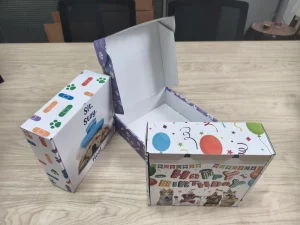Paper vs Plastic Packaging: Which Is the More Sustainable Choice?
Choosing between paper and plastic packaging is a crucial decision for businesses aiming for sustainability. This guide explores the advantages and disadvantages of paper and plastic packaging, helping you make an informed choice. Read on to discover how your choice impacts the environment and your brand.
Table of Contents
What Is the Environmental Impact of Plastic Packaging?
Plastic packaging is everywhere—from water bottles to food containers. But what impact does it have on the environment?
- Plastic Waste: Plastics can take hundreds of years to decompose, leading to plastic waste accumulation.
- Pollution: Plastic pollution harms wildlife and ecosystems.
- Production Emissions: Manufacturing plastics involves emitting greenhouse gases.
Plastic packaging poses a significant threat to our planet due to its non-biodegradable nature.
How Does Paper Packaging Affect the Environment?
Paper packaging is often seen as a greener alternative, but it’s essential to consider its environmental impact.
- Renewable Resource: Paper comes from trees, a renewable resource if managed sustainably.
- Biodegradable: Paper packaging is generally biodegradable and compostable.
- Production Impact: The production of paper can involve high water and energy usage.
While paper is more environmentally friendly, it still has ecological footprints to consider.

Advantages of Plastic Packaging
Despite environmental concerns, plastic packaging offers several benefits.
- Durability: Plastic is highly durable, protecting products effectively.
- Lightweight: Reduces shipping costs due to less weight.
- Versatility: Can be molded into various shapes and sizes.
- Cost-Effective: Generally cheaper to produce than alternatives.
Plastic’s properties make it a practical choice for many businesses.
Disadvantages of Plastic Packaging
However, the disadvantages are significant.
- Environmental Impact: Contributes to plastic waste and pollution.
- Non-Renewable: Made from fossil fuels, a non-renewable resource.
- Recycling Challenges: Not all types of plastic are recyclable.
- Consumer Perception: Increasingly negative view of plastic usage.
These factors make plastic less appealing in a world moving towards sustainability.
Advantages of Paper Packaging
Paper packaging offers several benefits over plastic.
- Eco-Friendly: Biodegradable and recyclable, reducing environmental harm.
- Renewable: Sourced from trees, which can be replanted.
- Consumer Appeal: Many consumers prefer eco-conscious packaging.
- Versatility: Suitable for various products and can be customized.
Using paper packaging can enhance your brand’s environmentally friendly image.
ALT
Consider our Kraft Product Boxes with Logo for sustainable packaging solutions.
Disadvantages of Paper Packaging
But paper isn’t without its drawbacks.
- Less Durable Than Plastic: Not as strong or water-resistant.
- Higher Cost: Can be more expensive than plastic packaging.
- Resource Intensive: Production can involve significant water and energy use.
- Weight: Heavier than plastic, potentially increasing shipping costs.
Understanding these disadvantages helps in making an informed decision.
Sustainable Packaging Solutions
Looking for a balance? Sustainable packaging might be the answer.
- Bioplastics: Made from plant-based materials, biodegradable.
- Recycled Materials: Use of recycled paper or plastic reduces waste.
- Minimalist Packaging: Reducing packaging materials altogether.
- Innovation: New materials like mushroom packaging are emerging.
By exploring sustainable options, businesses can minimize their environmental footprint.
Plastic Recycling: Is It Effective?
Recycling is often touted as a solution, but how effective is plastic recycling?
- Limited Recycling Rates: Only a small percentage of plastic gets recycled.
- Downcycling: Recycled plastic often becomes lower-quality products.
- Consumer Confusion: Not all plastics are recyclable, leading to contamination.
- Energy Usage: The recycling process itself consumes energy.
While recycling helps, it isn’t a complete solution to the plastic problem.
Choosing the Right Packaging Material
How do you decide between paper and plastic?
- Assess Product Needs: Consider durability, protection, and shelf life.
- Environmental Goals: Align packaging with sustainability objectives.
- Consumer Expectations: Meet the preferences of your target market.
- Cost Analysis: Balance the budget with the benefits.
Choosing the right packaging involves weighing these factors carefully.

Conclusion: Making an Environmentally Friendly Choice
When it comes to paper vs plastic packaging, there’s no one-size-fits-all answer. Consider the advantages and disadvantages of each material in the context of your business needs and environmental impact. By making an informed choice, you can contribute to a more sustainable future and enhance your brand’s reputation.
Key Takeaways:
- Plastic Packaging offers durability and cost-effectiveness but has significant environmental drawbacks.
- Paper Packaging is more environmentally friendly but may be less durable and more expensive.
- Sustainable Packaging Solutions like bioplastics and recycled materials offer alternatives.
- Plastic Recycling is helpful but not a complete solution to environmental concerns.
- Choosing the Right Packaging requires balancing product needs, environmental impact, and consumer expectations.
Explore our range of Customized Packaging Boxes to find the perfect packaging solution for your business.








